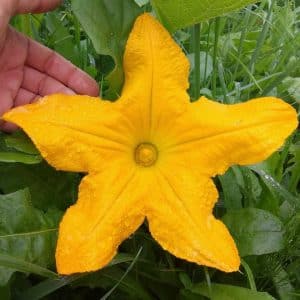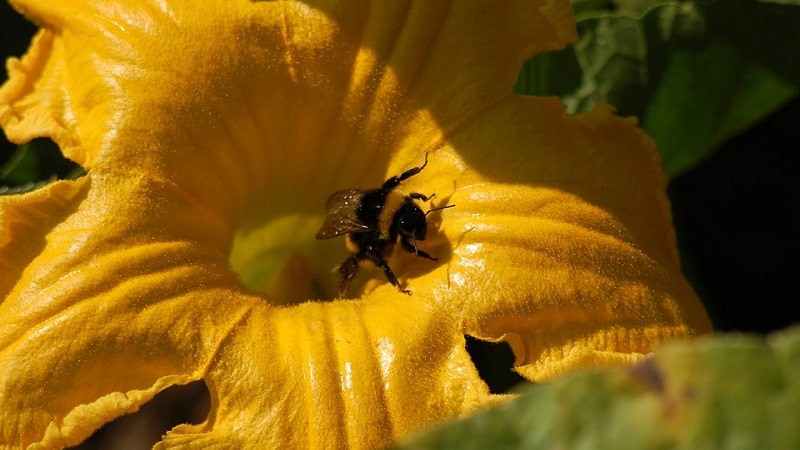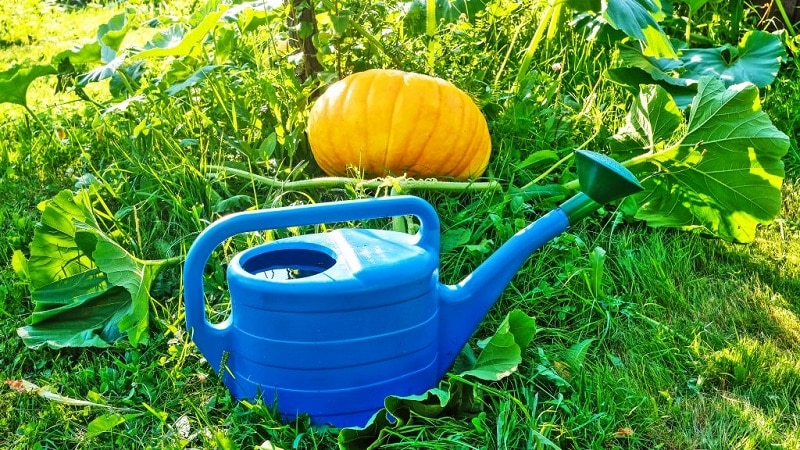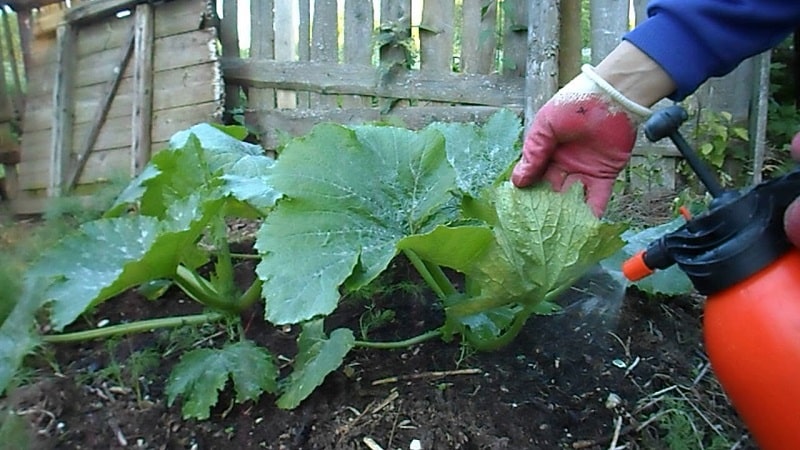What to do when a pumpkin does not bloom and why this happens
Pumpkin is an unpretentious plant that does not cause any particular difficulties in care. However, beginning gardeners often have the question of what to do if the sprouts have sprouted, leaves have formed, but there are still no flowers? Why doesn't the pumpkin bloom? You will receive detailed answers to these questions in the article.
Why doesn't the pumpkin bloom?
To answer the question of what to do if the pumpkin does not bloom, it is worth understanding what factors influence the development of the plant.
 Pumpkin begins to bloom 1.5-2 months after planting the seeds. The process of flower formation is influenced by the following factors:
Pumpkin begins to bloom 1.5-2 months after planting the seeds. The process of flower formation is influenced by the following factors:
- air and soil temperature;
- care;
- lighting;
- pollination;
- correct feeding.
Pumpkin grows well in sunny and ventilated areas with fertilized soil.
Important! If a crop is planted in a dark and humid place, its pollen sticks together and pollination does not occur.
Poor pollination
Bees collect nectar and carry pollen from one flower to another. Pumpkin has two types of flowers: male and female. It is easy to distinguish them: female flowers have pistils, and male flowers have stamens. Flowering of female flowers lasts 24-48 hours, male flowers - 24 hours.
Male flowers appear first, and female flowers appear a week later. If there are no female flowers, then the male flowers fall off, since pollination does not occur and ovaries do not appear.
Reference. If low-quality seeds are planted in the soil, the plant will not bloom. For planting, choose 2-3 year old seeds, not last year's ones.
Excess fertilizer
If gardeners use more fertilizer than recommended in the instructions, then the pumpkin will not be able to bloom and set fruit properly.
In the first stages of growth, fertilize the soil with a large amount of nitrogen substances negatively affects culture. The tops grow, but the roots do not develop and do not provide the entire plant with proper nutrition.
To help the pumpkin, leave a few healthy shoots and remove the rest. The stems are dug in so that additional roots are formed. This method improves plant nutrition.
Important! Weak shoots are not pulled out of the ground, but cut off. This method will not damage the root system.

Fruit deformity
If the plant is insufficiently nourished and the bush is not properly formed, pumpkins will develop ugly fruits.
Pinching is carried out so that many lashes do not form and the ovaries do not die. The optimal number of fruits on one plant is 3 or 4. Then all the pumpkins ripen in the correct shape.
It can be useful:
Why do pumpkin ovaries turn yellow and fall off?
Dense foliage
If the plant received more nitrogen than normal, then it has extra dense foliage. In this case, the crop does not set fruit and forms barren flowers.
Unnecessary leaves are removed and fertilizers containing phosphorus and potassium are used. The resulting lashes are sprinkled with earth.
Important! Phosphorus and potassium are involved in the formation of flowers. Timely feeding with these substances promotes the formation of new buds.

Root rotting
Excessive watering, sudden temperature changes, heavy rains - these factors cause the pumpkin roots to rot. The plant does not have enough strength to form flowers, the buds fall off, and the ovaries do not form.
Nitrogen fertilizers may be the cause of root rot. (they reduce the frost resistance of pumpkin), which were added to the soil ahead of schedule. Pumpkin is fed when the soil temperature is above +12°C.
If the weather is cold, watering is reduced and fertilizers are used that help the plant withstand the cold - for example, urea.
How to help a pumpkin bloom
How to make a pumpkin bloom? This question worries many summer residents who are worried about the harvest.
If all the requirements for proper plant care are met, but the pumpkin still does not begin to bloom, apply additional measures:
- artificial pollination;
- irrigation correction;
- formation of bushes;
- high-quality feeding.
Let's consider the technology and advantages of each method in detail.
Artificial pollination of pumpkin
This method is used if insects do not pollinate the flowers.. If you do not pollinate in time, the flowers will fall off.

First, determine what species the flower belongs to. If the bud is immediately followed by a stem, it is a male flower. If there is a slight thickening in front of the stem (ovary), it is female.
All actions are carried out carefully so as not to harm the buds. Carefully take the male flower, bend the petals and touch the stamen of the female bud with the pestle. Some time after the procedure, the second flower will increase in size.
Artificial pollination carried out in the morning. Closer to lunch, the flowers will close.
Allow pollination by male zucchini flowers. However, in this case, the future seeds will not be suitable for growing the crop.
Peculiarity. Do not water the plants before pollination. Water or dew that gets on the flowers will interfere with the fertilization process.
Proper watering
The flowering period affects the future harvest. If you irrigate the pumpkin incorrectly at this time, you will not get a high-quality harvest.

Pumpkin being watered once a week. The water is left to stand for 24 hours in a container in the sun. This way it heats up to ambient temperature. Before moistening, the soil is loosened and weeds are removed.
When watering, make sure that water does not get on the root collar of the plant. Wetting this part will cause the crop to rot.
Plant Formation
Great attention is paid to the formation of the bush. If the variety is large-fruited, then after the formation of ovaries, about 3 lashes are left on the plant. In June, the top of the shoot is pinched and 5 leaves are left.
For pumpkins of other varieties, the vines on which barren flowers have formed are removed. Top of the plant pinching in early August, all leaves except three are removed.
Reference. 1-2 ovaries are left on the plant if you want to get large fruits.
Feeding
For the pumpkin season feed 2-3 times. The first fertilizing is applied when 4-5 leaves appear on the pumpkin. At this time, organic fertilizers are suitable.
From mid-summer to August, the crop is fed every 14 days with mineral fertilizers. If the pumpkin is grown in seedlings, then 7 days before planting it, fertilizers are added to the soil. Use compost - 5 kg per 1 m².
To prevent rotting, fertilize with urea. Add 1 tsp to a bucket of water. substances. Fertilizing is carried out by irrigating the leaves.

Mineral fertilizers are suitable "Kemira Lux" and "Kemira Universal". They contain nitrogen, phosphorus, potassium, copper, boron, zinc and iron.
During the first period of the growing season, crops are fertilized with ammonia. 50 ml of the substance are diluted in 5 liters of water. The solution is poured strictly under the root.
Conclusion
During the flowering period, pumpkin becomes a capricious plant. Improper care leads to the fact that the flowers of the crop fall off and the ovaries do not form. To prevent this from happening, the pumpkin is artificially pollinated, since insects cannot cope with this.
Correct formation of bushes and timely fertilizing with nitrogen, phosphorus and potassium will allow the crop to quickly form flowers that will not fall off before fertilization.
Watering the crop is carried out with warm, settled water once a week. The soil is loosened and care is taken to ensure that moisture does not fall on the root collar. High humidity leads to rotting of the roots and falling off of the flowers and ovaries of the plant.